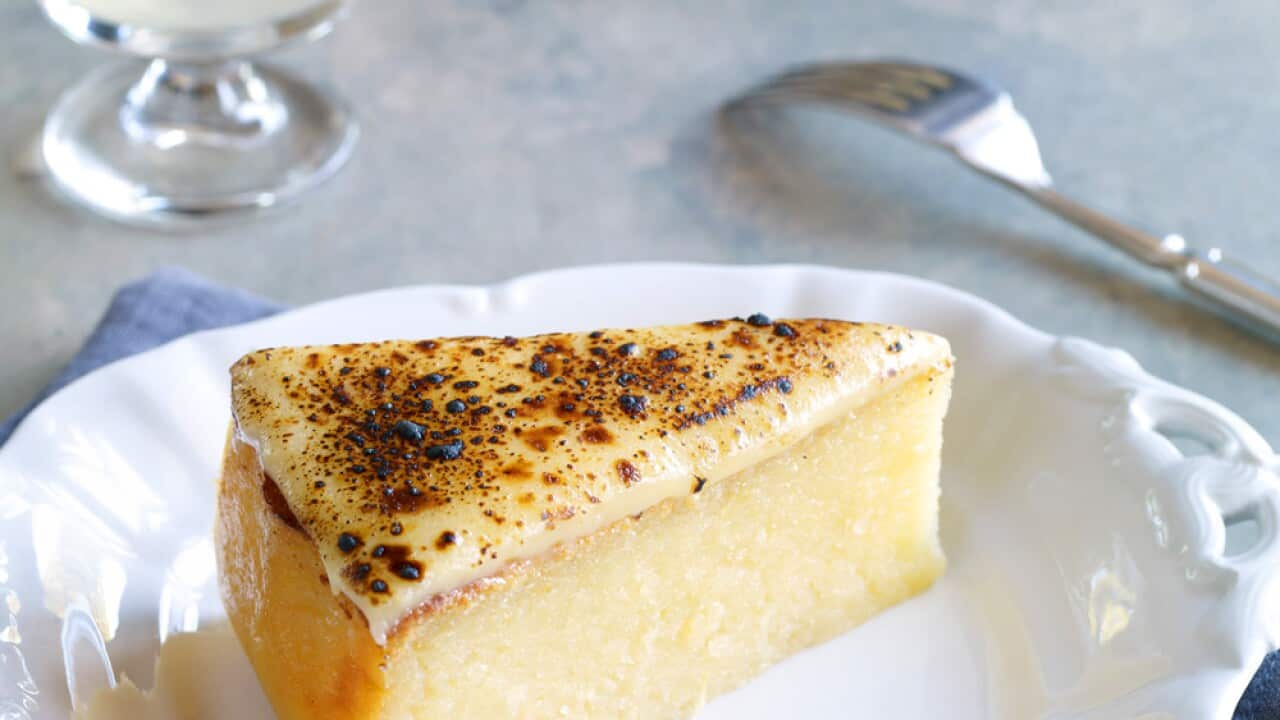serves
12
prep
20 minutes
cook
1:05 hour
difficulty
Easy
serves
12
people
preparation
20
minutes
cooking
1:05
hour
difficulty
Easy
level
Ingredients
- 900 g (2 lb) grated cassava
- 3 eggs
- 440 g (15½ oz/2 cups) caster (superfine) sugar
- 190 ml (6½ fl oz/¾ cup) evaporated milk
- 310 ml (10½ fl oz/1¼ cup) coconut milk
- 60 g (2 oz) unsalted butter, melted
Coconut caramel topping
- 2 tbsp plain (all-purpose) flour
- 400 g (14 oz) condensed milk
- 80 ml (2½ fl oz/⅓ cup) coconut milk
- 2 egg yolks
Instructions
Preheat the oven to 180°C (350°F/Gas 4). Lightly grease a 22 cm (8¾ inch) ovenproof dish about 7 cm (2¾ inch) deep.
To make the cake, place all of the ingredients in a bowl. Using an electric mixer, beat until well combined. Pour into the prepared dish and bake for 1 hour, or until firm in the centre. Remove from the oven and allow to cool slightly.
Meanwhile, to make the coconut caramel topping, place the flour and half of the condensed milk in a saucepan and stir to combine. Add the coconut milk and the remaining condensed milk, and cook over low heat for 10-15 minutes, stirring constantly until thickened to a jam-like consistency. Remove from the heat. Lightly beat the egg yolks in a bowl, then stir into the condensed milk mixture until well combined.
Pour the topping over the cake and spread evenly. Use a kitchen blowtorch to cook the topping until slightly caramelised. Alternatively, cook under a hot preheated grill (broiler) for 3-5 minutes; be careful as it will caramelise quickly. Set aside at room temperature until the topping is set and the cake is completely cool, then turn out the cake to serve.
Note
• Cassava (also kamoteng kahoy) is the edible tuberous root from the cassava plant. The hardy, carbohydrate-rich crop is a major food staple across the developing world; in the Philippines, it is predominantly eaten as a sweet. Boiled cassava topped with grated coconut and sugar is the most common form; grated for cassava bibingka is the most loved. The starch extracted from cassava, known as tapioca, is used as a flour, or balls (pearls) found in sweet merienda items, such as ginataan.
• Cassava (also kamoteng kahoy) is the edible tuberous root from the cassava plant. The hardy, carbohydrate-rich crop is a major food staple across the developing world; in the Philippines, it is predominantly eaten as a sweet. Boiled cassava topped with grated coconut and sugar is the most common form; grated for cassava bibingka is the most loved. The starch extracted from cassava, known as tapioca, is used as a flour, or balls (pearls) found in sweet merienda items, such as ginataan.
Recipes and images from 7000 Islands by Yasmin Newman, published by Hardie Grant Books, rrp $49.95.
Cook's Notes
Oven temperatures are for conventional; if using fan-forced (convection), reduce the temperature by 20˚C. | We use Australian tablespoons and cups: 1 teaspoon equals 5 ml; 1 tablespoon equals 20 ml; 1 cup equals 250 ml. | All herbs are fresh (unless specified) and cups are lightly packed. | All vegetables are medium size and peeled, unless specified. | All eggs are 55-60 g, unless specified.

